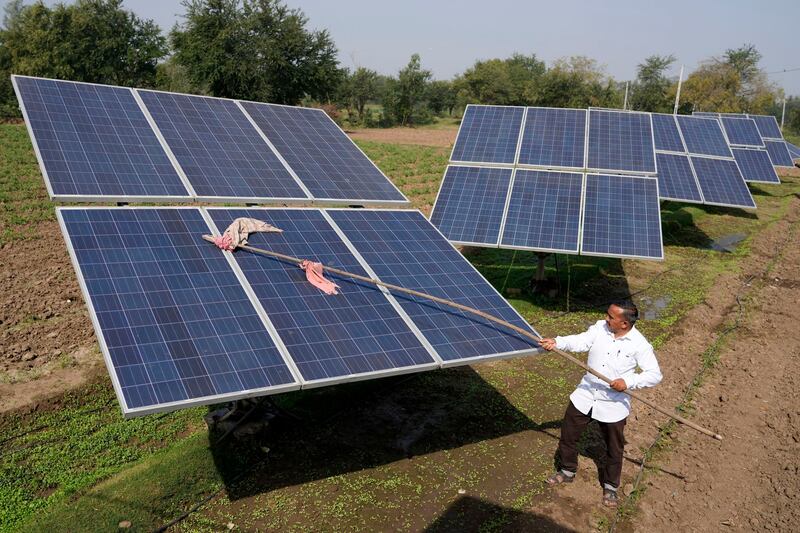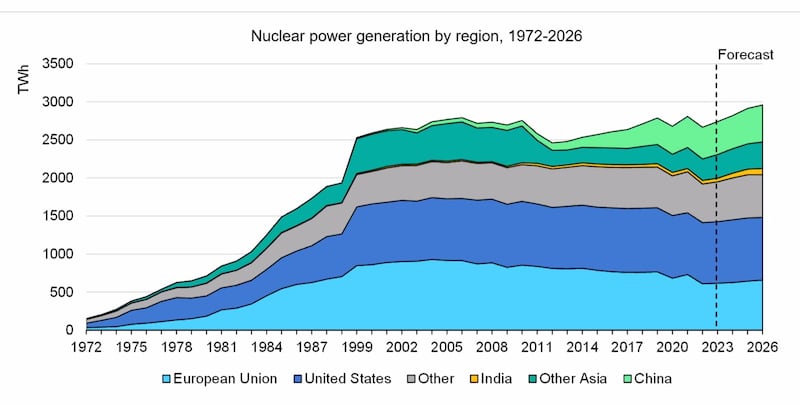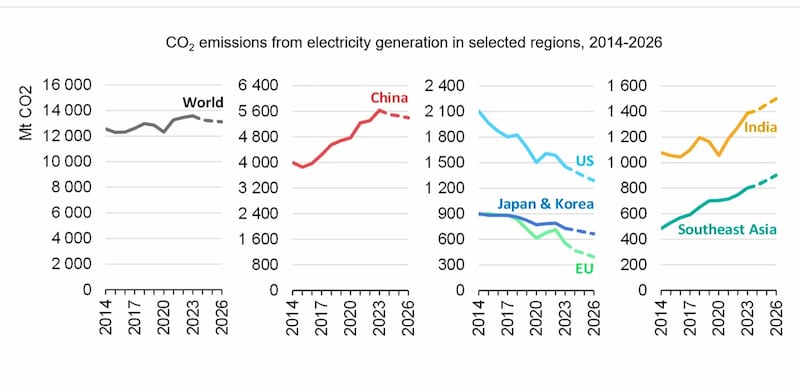UPDATED on January 24, 2024 at 11:32 a.m. ET.
A surge in global electricity demand over the next three years is expected to be entirely met by rapidly expanding renewables and a resurgent nuclear sector, marking a significant shift in the clean power transition, a report released Wednesday said.
While some of the rising demand, mostly emanating from Asia, will be met with coal-fired power generation, the International Energy Agency found that globally, there’s a concerted move away from the most polluting sources of electricity. It’s a trend that is key to climate change mitigation efforts.
"Record-breaking electricity generation from low-emissions sources – which includes nuclear and renewables such as solar, wind and hydro – is set to cover all global demand growth over the next three years," the Paris-based intergovernmental organization said in a report, Electricity 2024.
Low-emissions sources, which will reduce the role of fossil fuels in producing electricity globally, are forecast to account for almost half of the world’s electricity generation by 2026, up from 39% in 2023.
China, India, and Southeast Asian nations are projected to account for 85% of the global increase in electricity demand through 2026, the report found.
“The global additional electricity demand from 2024 to 2026 is about 2,900 TWh [terawatt hours],” Eren Cam, an electricity analyst at the IEA and the report’s principal author, told Radio Free Asia.
“China makes up almost half of this with a share of 48%. India is about 11% and Southeast Asia is 7%. So, these three regions combined account for roughly 70% of this growth,” Çam said.
“Rapidly expanding renewables are expected to meet all the additional demand growth in China,” Cam said.

According to the IEA, India has the highest increase in demand growth rate among the major economies and will add roughly equivalent to the current power consumption of the United Kingdom in the next three years.
“While renewables are set to meet almost half of this demand growth, one-third is expected to come from rising coal-fired generation,” said Cam.
“Southeast Asia is also expected to see robust electricity demand growth as the region’s economic growth accelerates. We expect renewables to meet around 40% of the demand growth, coal around 35% and gas at around 25% there,” he added.
Meanwhile, in advanced economies such as the United States and the European Union, renewables are set to more than offset demand growth displacing fossil-fired supply.
By 2026, Asia is expected to become the leading region in nuclear power, surpassing North America with the largest installed atomic capacity, driven by significant growth and new constructions in China and India.
Asia’s share of global nuclear generation is forecast to reach 30%, with over half of the new reactors set to be operational in these two countries.
China has added nuclear capacity of about 37 gigawatts (GW) over the past decade, increasing its share in global nuclear generation from 5% in 2014 to approximately 16% in 2023.

Electricity sector emissions
In 2023, China, India and numerous Southeast Asian countries experienced robust growth in electricity demand, though globally it decelerated.
Global emissions from electricity generation increased by 1% in 2023, due to growth in coal-fired power generation in China and India. It is expected to fall by more than 2% in 2024 and less than 1% after that.
In general, global emissions from the power sector are “entering a structural decline, as the expansion of renewable energy is accelerating and is also supported by the increases in nuclear generation,” Cam told an online news conference.

China is set to account for half of the declines in emissions globally over the next three years as the country’s electricity sector emissions are set to fall with the decline in coal-fired generation amid substantial expansion in renewables.
More than half of the world’s coal-fired generation occurs in China, where electricity demand growth will determine whether coal continues to play a major role in the electricity mix, according to Cam.
Edited by Taejun Kang and Mike Firn.
Updated with edits and to provide more details on the projected global growth in low-emissions energy sources.
